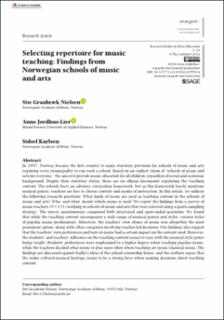Selecting repertoire for music teaching: Findings from Norwegian schools of music and arts
Peer reviewed, Journal article
Published version
Permanent lenke
https://hdl.handle.net/11250/3031700Utgivelsesdato
2022Metadata
Vis full innførselSamlinger
Sammendrag
In 1997, Norway became the first country to make statutory provision for schools of music and arts requiring every municipality to run such a school. Based on an explicit vision of “schools of music and arts for everyone,” the aim is to provide music education for all children, regardless of social and economic background. Despite their statutory status, there are no official documents regulating the teaching content. The schools have an advisory curriculum framework, but as this framework barely mentions musical genres, teachers are free to choose content and modes of instruction. In this article, we address the following research questions: What kinds of music are used as teaching content in the schools of music and arts? Who, and what, decide which music is used? We report the findings from a survey of music teachers (N=151) working in schools of music and arts that were selected using a quota sampling strategy. The survey questionnaire comprised both structured and open-ended questions. We found that while the teaching content encompasses a wide range of musical genres and styles, various styles of popular music predominate. Moreover, the teachers’ own choice of music was altogether the most prominent option, along with other categories involving teacher-led decisions. Our findings also suggest that the teachers’ own preferences and taste in music had a certain impact on the content used. However, the students’ and teachers’ influence on the teaching content seems to vary with the musical style/genre being taught. Students’ preferences were emphasized to a higher degree when teaching popular music, while the teachers decided what music to play more often when teaching art music/classical music. The findings are discussed against Kallio’s ideas of the school censorship frame, and the authors argue that the wider cultural-musical heritage seems to be a strong force when making decisions about teaching content.
Tidsskrift
Research Studies in Music Education
Med mindre annet er angitt, så er denne innførselen lisensiert som Navngivelse-Ikkekommersiell 4.0 Internasjonal
Beslektede innførsler
Viser innførsler beslektet ved tittel, forfatter og emneord.
-
Knowing music as representation or as operation: Exploring musical diversity through collaborative music making in Kaleidoscope
Kvaal, Camilla (Peer reviewed; Journal article, 2021)A society considered to be in a multicultural condition is likely to condition the way things are seen and what is seen as important. Attention is likely to be drawn to difference and diversity and the prospects of including ... -
Children's subject positions in discourses of music in everyday life: Rethinking conceptions of the child in and for music education.
Vestad, Ingeborg Lunde (Journal article; Peer reviewed, 2014)In this article I discuss children’s everyday uses of recorded music (such as CDs, Mp3-files) in the light of sociological notions of “children” and “childhood”. The discussion provides perspectives on musical engagement ... -
Pop Music for Kids: Sonic Markers as Narrative Strategies in Children’s Music
Askerøi, Eirik (Journal article; Peer reviewed, 2017)Whilst the creative handling of recording technology has played a major role in the development of popular music, there has been little research into the role of production in music promoted explicitly for a child audience. ...

